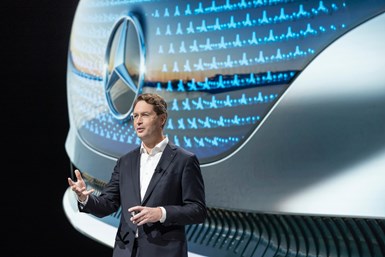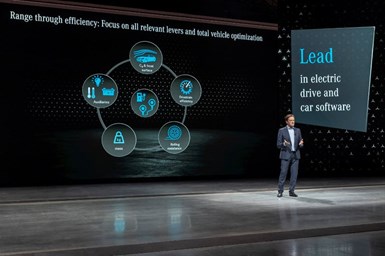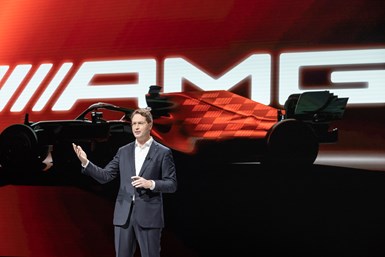Mercedes Targets Profitable Future with EVs
Plans include cutting costs by 20% and achieving a double-digit operating margin.
Daimler Chairman Ola Kallenius outlined an aggressive, five-year strategy for the company’s Mercedes-Benz luxury unit on Tuesday morning during a virtual presentation to analysts and investors.
The comprehensive plan consists of six pillars:
- Think and act like a luxury brand
- Focus on profitable growth
- Expand customer base by growing sub-brands
- Embrace customers and grow recurrent revenues
- Lead in electric drive and car software
- Reduce the cost base and improve industrial footprint

Ola Kallenius (Images: Mercedes-Benz)
The strategy aims to lower the carmaker’s breakeven point and enable a mid-to-high single-digit operating profit margin. That’s under unfavorable market conditions. If things are going well, Kallenius expects Mercedes will return a double-digit margin.
“We will make a leap forward in technology. We will invest where we can win, grow more intelligently and reshape our industrial footprint,” he explains. “As a result, we will be able to improve profitability and lift shareholder value.”
Electric Future
Much of the growth hinges on a coming wave of next-generation electric vehicles.
The rollout begins next year with the EQS luxury sedan that Mercedes says will have a 700-km (434-mile) driving range on the WLTP cycle. It will be followed by the EQE sedan, EQS SUV and EQE SUV, all of which will be underpinned by Mercedes’ upcoming large car EV architecture.

Mercedes COO Markus Schafer
After 2025, Mercedes will launch a second dedicated electric platform, the Mercedes-Benz Modular Architecture (MMA), designed for compact and midsize cars.
In addition to new vehicles, Mercedes will shift more of its product development resources and expertise to electric drive systems, including internally developed electric motors and inverters. The company also is launching a new technology program, dubbed Vision EQXX, that targets “spectacular efficiency and range” that can quickly be applied to production cars.
Electrified models are expected to account for more than half of Mercedes’ global vehicle sales by 2030, according to Markus Schafer, Daimler r&d chief and Mercedes COO. By that time, the number of piston engine variants Mercedes offers will be 70% fewer than are available today.
Schafer also expects EVs will contribute to the company’s bottom line. “From 2025 on, we are targeting strong contribution margins for all new architectures,” he says, “thanks to high commonality and controlled investment, and ongoing falls in the cost of battery systems.”
With the help of several partners, Mercedes aims to reduce battery cost to below €100 ($117) per kilowatt-hour by 2025.
Sub-Branding
Mercedes also plans to transition its AMG performance, Maybach ultra-luxury and G utility sub-brands to electric power.

“The new strategy will take them to the next level, accelerating their development, with clear and targeted plans to unlock their potential and drive substantial incremental EBIT growth,” Mercedes says.
The first electrified AMG model is due next year. The unit also will intensify its partnership with Formula One racing in 2021.
Plans for Maybach include expanding internationally and doubling its global sales volume.
New Sales Channels
To complement traditional car sales, Mercedes is targeting new revenue streams such as over-the-air updates and subscription services.
Estimating that its connected fleet will total 20 million vehicles by 2025, Mercedes says that targeting such applications will spark rapid growth and boost overall brand loyalty.
Addition by Subtraction

Mercedes CFO Harald Wilhelm
The new strategy also calls for trimming fixed costs, capital expenditure and r&d costs by more than 20% by 2025 compared to 2019 levels. The targets will be achieved via a combination of reduced spending, capacity adjustments and lower personnel costs, according to the carmaker.
Variable costs will be reduced by 1% per year through 2025, including “increased and prolonged savings” for material costs.
Savings also will be achieved through manufacturing processes. The redesigned S-Class sedan, for example, takes 25% less time to build than its predecessor.
Bottom Line
“We will focus on winning where it matters: dedicated electric vehicles and proprietary car software,” Kallenius asserts. “We will take action on structural costs, target strong and sustained profitability.
“We intend to build the world’s most desirable cars.”
RELATED CONTENT
-
On Zeekr, the Price of EVs, and Lighting Design
About Zeekr, failure, the price of EVs, lighting design, and the exceedingly attractive Karma
-
on lots of electric trucks. . .Grand Highlander. . .atomically analyzing additive. . .geometric designs. . .Dodge Hornet. . .
EVs slowdown. . .Ram’s latest in electricity. . .the Grand Highlander is. . .additive at the atomic level. . .advanced—and retro—designs. . .the Dodge Hornet. . .Rimac in reverse. . .
-
Electrically Improving Powertrains
The good news about downsized powertrains is that they can provide greatly improved fuel efficiency compared to larger engines. The not-so-good news for many drivers of cars with these smaller engines under the hood is that they can lack performance.








